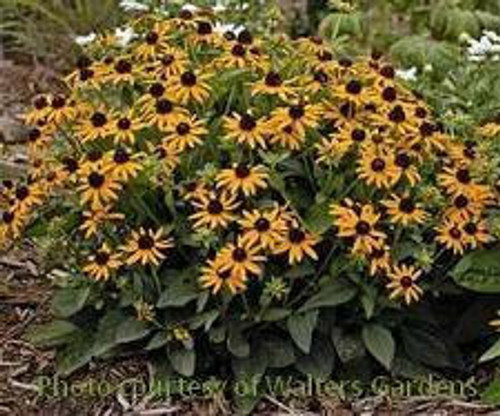Product Description
Rudbeckia fulgida 'Goldsturm'
Common Name: Black-Eyed Susan, Coneflower.
Zones 4 to 10, Sun.
Plants reach 24 inches tall and 18 to 24 inches wide;
Growth rate: Moderate, easy to grow.
Rudbeckia fulgida 'Goldsturm' is a true garden superstar, celebrated for its vibrant golden blooms and reliable performance. It is a classic choice for adding a burst of sunshine to any landscape. Here's why 'Goldsturm' is a favorite among gardeners:
- Profuse Golden Blooms: 'Goldsturm' produces a dazzling display of golden-yellow, daisy-like flowers with prominent dark brown center cones. These cheerful blooms appear in abundance from mid-summer to early fall, creating a long-lasting spectacle of color.
- Adaptable and Hardy: This Black-eyed Susan thrives in a wide range of conditions and is hardy in USDA zones 4-9. It tolerates heat, humidity, and even some drought, making it a reliable choice for various climates.
- Pollinator Magnet: The nectar-rich flowers attract a multitude of pollinators, including bees, butterflies, and other beneficial insects, making it a valuable addition to any wildlife garden.
- Low Maintenance: 'Goldsturm' is known for its easy-going nature and requires minimal care once established.
- Versatile: It is a fantastic choice for borders, mass plantings, meadow gardens, and even containers.
Growing Tips:
- Sunlight: Plant in full sun (at least 6-8 hours per day) for the best flowering. It can tolerate some light shade, but the bloom may be reduced.
- Soil: Prefers well-drained soil but is adaptable to various soil types, including clay and poor soils.
- Water: Water regularly, especially during hot, dry periods, but avoid overwatering. Once established, it has good drought tolerance.
- Maintenance: Deadhead spent flowers to encourage continuous blooming. You can also divide the clumps every few years to maintain vigor and prevent overcrowding.
Design Ideas:
- Borders: Plant in groups or drifts to create a bold splash of color in borders and flower beds.
- Mass Plantings: Create a stunning meadow-like effect by planting 'Goldsturm' en masse.
- Containers: Its manageable size makes it suitable for container gardening, adding a cheerful touch to patios and decks.
- Meadow Gardens: Combine with other native wildflowers and grasses for a naturalized look.
- Cut Flowers: The long-lasting blooms make excellent cut flowers for bouquets.
1999 Perennial Plant Association Plant of the Year.
Royal Horticultural Society's Award of Garden Merit 1993
Royal Horticultural Society's Award of Garden Merit 2002
Bright gold petals with a deep brown cone highlights the garden in late summer. 'Goldsturm' is a long-blooming, low maintenance perennial. Disease and pest resistant, with long lasting cut flower. Provides seeds in the winter for birds and nectar for butterflies. Adaptable to a wide variety of soil conditions in full to partial sun. Once established, spreads somewhat rapidly. Deadhead to prolong blooming season. Outstanding in mass plantings as a border perennial, meadow and prairie gardens as well as a noninvasive groundcover.
Ten (10) plants in quart containers per flat (or tray).
Other Details
The most important part of the plant is its root system. Healthy roots are the foundation of a healthy, vibrant plant. The type of plug container used is based on the specific needs of the plants. Perennials offered as bare root traditionally perform better when planted as bare root.Planted in a specialized mix, potted plants have well established root systems. Top growth stage will vary depending on the current life cycle and time of year when shipped. In Winter and early Spring dormant plants may be shipped. Dormant plants may be planted right away, even before the last frost date.
Most bare root varieties are field grown for at least one season, though Hemerocallis and Hosta are grown for two seasons. The bulk of the soil is removed during the harvesting process and the tops of most varieties are trimmed back to the crown. They are graded, packed in shredded aspen or sphagnum moss and stored in freezers until ready to be shipped.
See our Container Sizes and Bare Root Perennials pages for more information.
Plant information and care is provided in the Overview section, Plant Genus Page and general information is provided in the Planting Care & Guides. Additional questions can be asked on each Plant page.
Plant Spacing: Using the maximum mature spread or width of a plant to guide spacing, ensures space to grow to full size. To fill an area sooner, plant them closer together. Just remember, future thinning or transplanting may be needed.
Water: Keep a close eye on newly planted perennials, especially throughout the first growing year. Most early plant loss is due to too much or too little water!
















